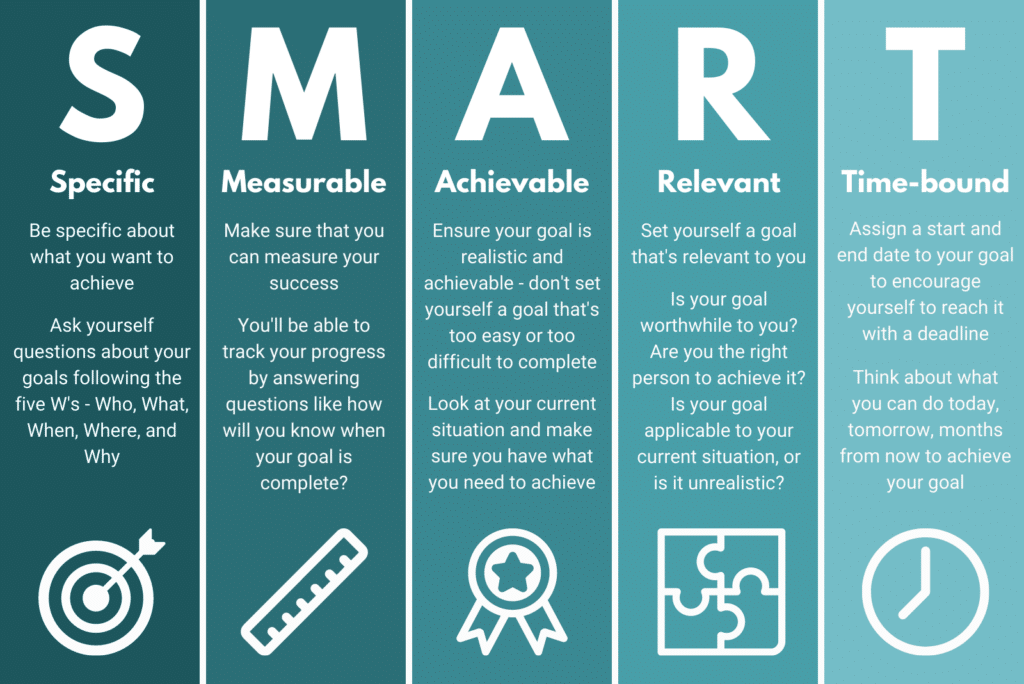SMART goals are a goal-setting framework that can help you to stick to your goals and get the most out of them. In this guide we’ll explain how you can use SMART goals as a teaching assistant to improve your work and the experience of your students!
What are SMART goals?

How to set goals as a teaching assistant
When you’re setting goals for yourself as a teaching assistant it’s important to keep in mind 2 things: what the teacher you’re working with needs and what the students you’re helping to teach require.
It’s important that you get to know the teacher you’ll be working with and their needs around the classroom. Try asking what you could to help them out in a way that suits them (and you!), so that you can work better together.
Some teachers or schools might want a more active teaching assistant that participates heavily in lessons, while others might opt for a more hands-off approach where you’ll only be handling specific tasks. Whatever the case, it’s important to know where you’re needed before you start setting goals for yourself. Try asking yourself what can you achieve in your role with your current responsibilities. What tasks can you do to help deliver learning in the classroom?
You should have some idea of what each of the students in your class requires and how you can best help them to learn as you spend time with them in the classroom. When you’re setting your goals try to centre your students and what they need to progress. Can you think of any particular students that require more help? Is anyone struggling with the work they’re set? Having an answer to questions like this can help to inform your goal setting and what you need to focus on.
Now that you know the basic principles of SMART goals and what you should be keeping in mind when you’re setting your own SMART goals, we’re going to go over a few examples to give you a better idea of how you can get started.
Examples of SMART goals for teaching assistants
1. Professional development
“I will continue my professional development by getting my Level 2 Award in Support Work in Schools and Colleges qualification within the next 6 months, so that I can improve my job prospects and perform better at work.”
S: There is a goal to achieve a specific qualification, not just “a teaching assistant qualification”.
M: You can use the timeframe of 6 months to measure your goal, narrowing it down further when you’re enrolled on a course. You will have actual deadlines for the end of your qualification to further help.
A: The Level 2 Award doesn’t require any other qualifications or experience, so it’s a reasonable goal for a teaching assistant looking to improve their job prospects.
R: Achieving a qualification will be helpful, as mentioned, for both improving job prospects and work performance and is extremely relevant for someone working in a teaching assistant position.
T: There is a firm goal of 6 months. It gives enough room to successfully prepare what you’ll need (support from work, planning to fit study around your work and home life, etc.) and is a realistic timeframe for someone to achieve their Level 2 qualification.
2. “Communication”
“Due to consistent communication issues, I will allocate time every Friday at the end of the school day to check in with the teacher I’m supporting to try and improve our communication. I will re-evaluate how this is helping at the end of the school term and decide on a course of action from there.”
S: An issue has been clearly identified and the process of reaching the goal has been laid out with specific days and times.
M: This is more vague, but this goal has a means of evaluation built into the end of it. By evaluating if communication has improved you can measure the goal’s success.
A: This is definitely an achievable goal with a clear plan of what to do and how to do it. This goal makes use of simple, easy to do tasks that should be easy to stick to even in a chaotic school environment.
R: This is something that the teaching assistant in question is struggling with consistently, so reaching their goal is very relevant to their work life and personal progression.
T: With a clear deadline of the end of term, this goal has a set end date but it has flexibility built into it as this is a potentially continuous goal.
3. “Helping a student”
“I will help a student who is struggling with literacy to improve their reading comprehension by conducting one-on-one sessions with them twice weekly and check their progress at the end of each term by seeing how close they are to progressing to the next reading level.”
S: This goal is specific and focused on a particular student and action plan of one-on-one sessions. When planning a goal like this it’s important to take into account individual needs. Try thinking about what learning method would best suit a student you’re working with!
M: Schools use a level system for reading so it’s easy to measure if a child is making meaningful progress. This example sets out a clear measure of success for the goal by using this.
A: This is a difficult aspect of this goal as it can depend from child to child and how they respond to their learning. With the reasonable amount of time set out for the goal and scheduled sessions there’s no reason on the planning side that it shouldn’t be achievable.
R: This goal is aimed towards a child struggling with literacy so this goal is relevant to the situation. The specific tasks that have been laid out are focused towards working on the goal.
T: In this example there is a clear timescale laid out with the review time at the end of the term, as well as the two days in the week set aside to help complete the goal.
SMART goals can be extremely helpful when you’re working as a teaching assistant and are also applicable to many situations outside of work too! They can help set you up for success in an environment where a diverse range of issues can come up. Though SMART goals don’t always apply to the things you want to do, they’ll generally help you make your goals clearer and give you something to work towards when compared to vaguer goals.






